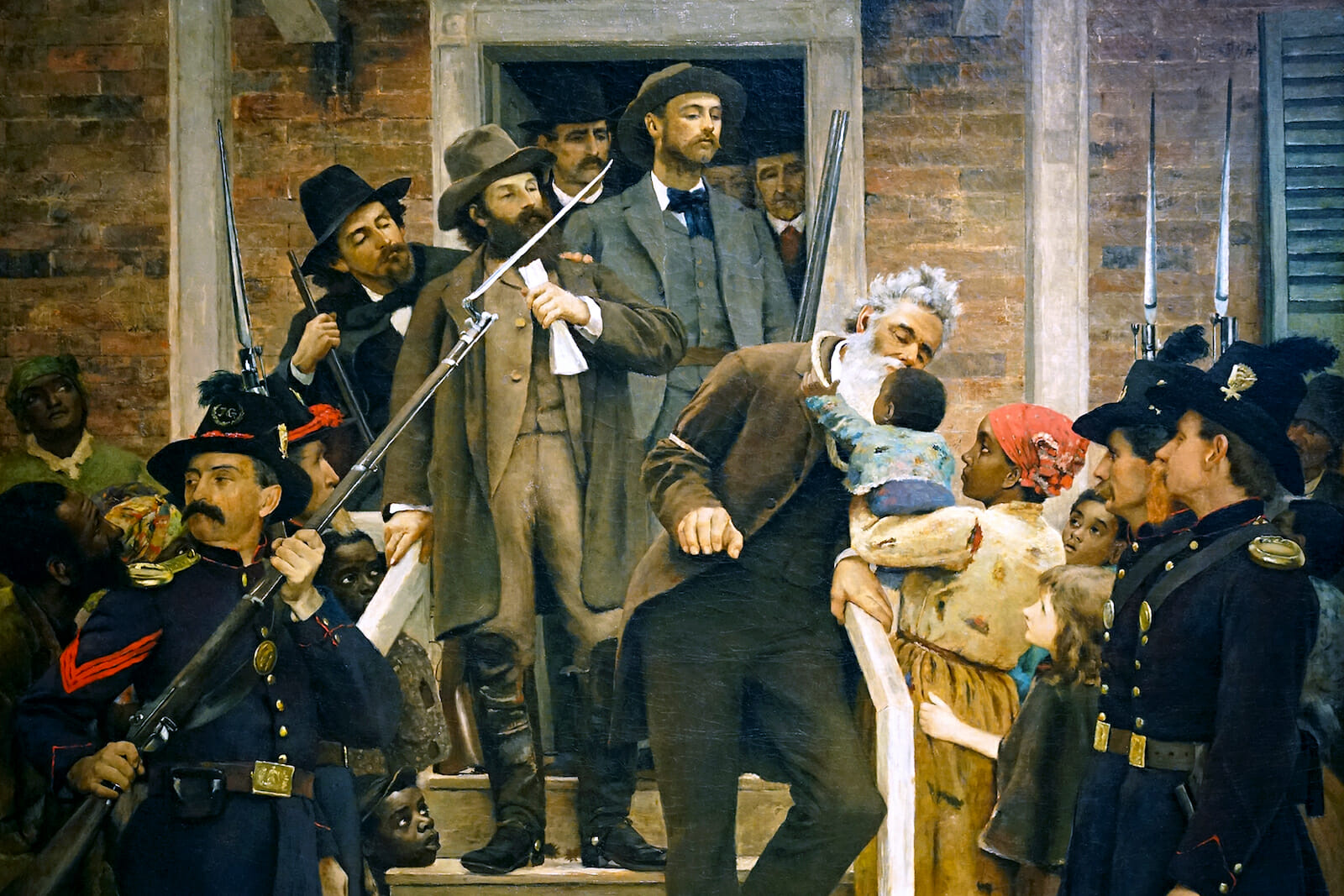
Culture
American Spartacus: John Brown, an American Hero
In Roman history, there were 3 Servile Wars. The Third Servile War began approximately 73 BCE and lasted until approximately 71 BCE. The Third Servile War has been glamorized by Hollywood in movies and in a TV series concentrating on a Thracian slave named Spartacus, who has become a household name throughout the world as a freedom fighter who rebelled against slavery. Senator Corey Booker in a Senate confirmation hearing, proclaimed openly that he was “Spartacus.” Yet, if there ever was an American Spartacus, his name was not Corey Booker. It was a failed businessman who became convinced that he was the appointed messenger of God, called upon by God to end slavery in the United States; his name was John Brown.
Slavery in the United States
Slavery became a contentious issue in the 2nd Continental Congress. In the initial draft of the Declaration of Independence, Thomas Jefferson included the following: “He has waged cruel war against human nature itself, violating its most sacred rights of life & liberty in the persons of a distant people who never offended him, captivating & carrying them into slavery in another hemisphere or to incur miserable death in their transportation thither.”
This clause was eliminated during the discussion on the ratification of the Declaration of Independence. While history has mostly pointed the finger of this heinous act at the South, the brutal truth is that the North also benefited from slavery. While it must be pointed out that the North did favor eventual emancipation, at the 2nd Continental Congress, the North was not prepared to grant immediate emancipation of the slaves in the new nation. Slavery was a foundation of the new nation’s fragile economy, and then, as of now, one’s profits came before social or moral sentiment. It was this failure to deal with the issue of slavery in the new nation’s birth that was the main cause of the American Civil War, and the movement personified by John Brown.
The rise of John Brown
John Brown was born on May 9, 1800, to Owen Brown and Ruth Mills in Torrington, Connecticut. His father operated a successful tannery in Hudson, Ohio. One of Owen Brown’s apprentices while in Ohio was Jesse Grant, father of future general and U.S. president, Ulysses S. Grant. Owen Brown was also a wealthy land speculator and close friends with the famed abolitionist Frederick Douglas. Owen was an active member of the Underground Railroad as well.
John Brown originally wanted to be a minister, and at the age of 16 he enrolled at the Morris Academy in Litchfield, Connecticut, but due to illness was forced to drop out and return to Ohio where he opened his own tannery with his adopted brother. For the majority of his business life, John Brown was successful, but in the Panic of 1837, having invested heavily in state bonds and over-extending his credit, John Brown was forced to declare bankruptcy. Brown was re-establishing himself as a dealer in sheep and horses when the Crisis of 1839 hit, and he was wiped out along with many other small business’.
Even during his successful business career, John Brown was actively involved in the anti-slavery movement, and his tannery was a major way station of the Underground Railroad.
John Brown had a deep revulsion against slavery, and he honestly believed it was against God’s law for human beings to own other human beings. It was after the murder of Elijah P. Lovejoy in 1837 that John Brown consecrated his life to the destruction of slavery in the United States.
Upon the death of members of his family to dysentery, Brown with his new wife, and business partner moved to Springfield, Massachusetts to found a business in wool, but was ultimately unsuccessful because of the cartel of low-quality wool producers. It was in Springfield that Brown joined the Sanford Street Free Church, now known as the St. John’s Congregational Church. It was here where Brown became more and more radicalized against slavery. Frederick Douglas was a constant fixture at this church, and once spent the night speaking with Brown on the subject of slavery. Douglas would later write in his autobiography, “From this night spent with John Brown in Springfield, Mass. [in] 1847, while I continued to write and speak against slavery, I became all the same less hopeful for its peaceful abolition. My utterances became more and more tinged by the color of this man’s strong impressions.”
While Brown considered his time in Massachusetts a failure, it would later lead Brown to finding the financial support he would need for his activities in Kansas, and in the attempted rebellion at Harper’s Ferry. If there was a catalyst for Brown’s violent struggle against slavery, it is the passage of the Fugitive Slave Act of 1850, and the sermon delivered at the Sanford Street Free Church where the pastor, the Reverend John Mars, preached that the time had come to beat plowshares into swords.
In 1855, with his son’s and their families being threatened by pro-slavery groups in Kansas, Brown traveled to Kansas with his son-in-law, stopping on the way to collect weapons and money from anti-slavery businessmen in New York and in Ohio. While Brown has been universally condemned for the murder of several pro-slavery men with broadswords, less attention has been paid to the genesis of this attack at Pottawatomie Creek, the attack by pro-slavery men on Lawrence, Kansas which destroyed two anti-slavery newspapers and the Free State Hotel. After several violent encounters with pro-slavery forces, Brown accepted an offer of clemency by the territorial governor and returned to the North. It is here, that John Brown laid his plans to take Harper’s Ferry and to lead a slave rebellion in the South.
While Brown was circumspect about his intentions in regard to his followers, he confided in his plans to Frederick Douglas. Writing in his autobiography, Douglas said: “The taking of Harper’s Ferry, of which Captain Brown had merely hinted before, was now declared as his settled purpose…He did not at all object to rousing the nation; it seemed to him that something startling was just what the nation needed. He had completely renounced his old plan, and thought that the capture of Harper’s Ferry would serve as notice to the slaves that their friends had come, and as a trumpet to rally them to his standard. He described the place as to its means of defense, and how impossible it would be to dislodge him if once in possession.”
On October 16, 1859, the raid on Harper’s Ferry began.
Aftermath of the raid on Harper’s Ferry
The circumstances regarding the raid on Harper’s Ferry have been discussed ad nauseam, so it will not be recounted here. While we know that John Brown was convicted of treason against the Commonwealth of Virginia, it is puzzling as to why he (Brown) was convicted in a state court for what was essentially a federal crime.
Harper’s Ferry was a federal institution, and the crime Brown was accused of, and convicted of, occurred on federal property. Yet, John Brown was not tried in federal court, but in a court of the Commonwealth of Virginia. The crime he was tried for, and convicted on, was for treason against the Commonwealth of Virginia.
In the United States Constitution, there is in Article VI, paragraph 2: “This Constitution, and the Laws of the United States which shall be made in Pursuance thereof; and all Treaties made, or which shall be made, under the Authority of the United States, shall be the supreme Law of the Land; and the Judges in every State shall be bound thereby, any Thing in the Constitution or Laws of any State to the Contrary notwithstanding.”
There can be no doubt as to the culpability of John Brown’s responsibility for his actions in the illegal seizure of Harper’s Ferry. But the question of jurisdiction must give any dis-interested observer pause as to the legality of Brown’s trial and the abandonment of federal law in deference to the intense political situation created by Brown’s actions. President Buchanan abandoned Brown to his fate because of fears such a federal trial of Brown would incite a constitutional crisis which might ignite a Civil War.
Buchanan’s action did not prevent an American Civil War, he merely delayed the inevitable, and allowed the South to arm and to prepare trained troops for the coming conflict. On December 2, 1859, John Brown was taken to the gallows and hanged for treason against the Commonwealth of Virginia.
Sixteen months later, the American Civil War began. In April of 1865, the Thirteenth Amendment to the United States Constitution was passed, and slavery was outlawed throughout the United States and any territory controlled by the United States.

